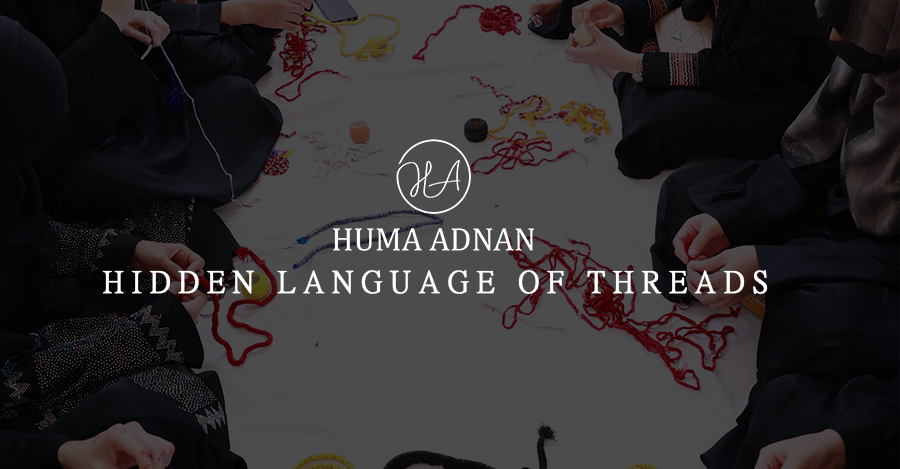Threaded Legacies: The Hidden Language of Stitches by Craft Stories

Some stories aren’t told through words—they're whispered through needle and thread.
In a world spinning on the axis of fast fashion, where trends fade as swiftly as they rise, Craft Stories by Huma Adnan is taking the slow road—and what a beautiful road it is!
It's not paved with glitter or gloss, but with grit, heritage, and hands that have known both hardship and hope.

From Dust to Design: The Revival of the Vanishing Thread
“It’s so good that a craft once limited to a small region is now celebrated globally,” says Huma Adnan, whose brand has become a beacon for indigenous artistry. And she’s right—without this platform, these stunning stitches might have been swept away by time, lost like whispers in the wind.
These stitches carry the ancestral rhythms of Afghan refugees and artisans from Hunza and Balochistan—each loop a legacy, each knot a vow not to forget.
And oh, what stitches they are!

Pukhta Dozi: The Strength in the Stitch
Let’s start with the aptly named Pukhta Dozi. As solid as its name suggests, Pukhta means "strong" and Dozi means "stitch"—this is the backbone of Afghan embroidery.
And trust us, it’s no less than a muscle-flex of craftsmanship.
Every thread is first spun by hand, then dyed, then sewn—each piece taking, on average, three days to complete. But turn it over, and you’ll find… nothing. No visible flaws. No messy threads. It’s cleaner on the inside than most of us are after a therapy session.
That’s the invisible perfection of Afghan finishing!

Gireh Dozi: The Poetry of Knots
Then there is Gireh Dozi—the stitch of stories. Gireh, meaning "knot" in Persian, sounds poetic—and rightly so. This isn’t just embroidery—it’s endurance woven with elegance.
Artisans like Pari Gul, working with Craft Stories, are self-taught and silently skilled. It takes two full days to complete just one motif. Two days. Ten micro stitches twisted together to form each design. Talk about tying history together—literally. Used on dupattas, caps, handkerchiefs, and cherished bridal wear, Gireh Dozi is a proud signature of Afghan craftsmanship.

Zanjeer Dozi: A Chain Reaction of Beauty
Ah, Zanjeer Dozi—the chain stitch that binds not just thread to fabric, but people to purpose. Here’s the technique: start with a chain-link border, then layer it with the boldness of Pukhta Dozi, creating textures with striking dimension. Together, they form a tapestry as rich and intricate as Afghan storytelling—layered, looped, and lovingly laced. Each piece of Zanjeer Dozi is a tribute to connection—to memories, to meaning.
 Kacha Tanka: The Raw Pulse of Tradition
Kacha Tanka: The Raw Pulse of Tradition
Every masterpiece begins with a humble beginning.
Raw, running, real…
Kacha Tanka—also known as the “raw stitch”—is the foundation on which innovation is embroidered. It’s a running stitch that may appear simple, but don’t be fooled—this is where the soul starts singing. Its simplicity belies its impact. Combined with beadwork—a forte of Afghan artisans—these "raw" stitches breathe life into fabric, with beads shimmering like dew on desert roses.
 Global Threads, Local Hands
Global Threads, Local Hands
These stitches are signatures of survival! Whether it's beaded cushions, embroidered jackets, or flip-flops approved in Japan, each motif is a memoir in thread. And now, these once-hidden crafts are sashaying down global runways, showcasing collections that are modern yet rooted—silently screaming a story worth remembering.

The Last Word: Stitch by Stitch, Story by Story
As the world hurtles forward, Craft Stories pulls us gently back—back to heritage, back to humanity. With stitches that take days and women who’ve spent lifetimes perfecting them, this is more than fashion. This is memory. This is meaning.
This is slow craft with a fast-beating heart.
So the next time you see a thread trailing off the hem—don’t pull it.
Follow it. It might just lead you to a legacy.

